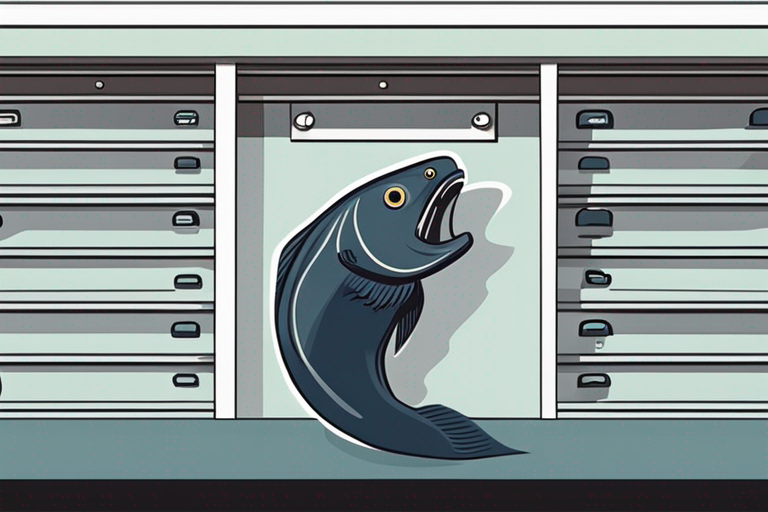
Preserving Atlantic Wolffish for Long-Term Storage: Best Practices
Get Your Free Food Safety Cheat Sheet
30 most common foods with instant answers. Print it and stick it on your fridge—completely free!
Preserving Atlantic Wolffish for Long-Term Storage: Best Practices
When it comes to preserving Atlantic Wolffish for long-term storage, it is essential to follow proper guidelines to maintain its quality and safety. Atlantic Wolffish, also known as Anarhichas lupus, is a delicious and nutritious fish with a unique flavor profile, making it a popular choice for seafood enthusiasts. In this blog post, we will explore the best ways to preserve Atlantic Wolffish to ensure it stays fresh and safe for consumption. (Atlantic wolffish)
Understanding Atlantic Wolffish
Before delving into the preservation methods, let's learn more about Atlantic Wolffish. This species of fish is found in the cold waters of the North Atlantic Ocean, particularly around Iceland, Greenland, and Norway. Atlantic Wolffish have a distinctive appearance, with a long, eel-like body and prominent teeth. They are known for their mild, sweet flavor and firm texture, making them a versatile ingredient in various culinary dishes.
Atlantic Wolffish is a rich source of essential nutrients, including omega-3 fatty acids, protein, vitamins, and minerals. Incorporating this fish into your diet can offer numerous health benefits, such as supporting heart health, brain function, and overall well-being.
Guidelines for Preserving Atlantic Wolffish
Preserving Atlantic Wolffish for long-term storage requires careful handling and storage practices to maintain its freshness and flavor. Here are some best practices to ensure the quality and safety of the fish:
1. Proper Cleaning and Filleting
Before preserving Atlantic Wolffish, it is crucial to clean and fillet the fish properly to remove any scales, bones, and internal organs. Follow these steps for cleaning and filleting:
- Rinse the fish under cold water to remove any debris or blood.
- Use a sharp knife to fillet the fish, removing the skin and bones.
- Cut the fillets into desired portions for storage.
2. Freezing Atlantic Wolffish
Freezing is one of the most effective ways to preserve Atlantic Wolffish for an extended period. Follow these steps for freezing the fish:
- Wrap the fillets individually in plastic wrap or aluminum foil to prevent freezer burn.
- Place the wrapped fillets in airtight containers or freezer bags.
- Label the containers with the date of freezing to track freshness.
- Store the fish in the coldest part of the freezer at 0°F or below.
3. Vacuum Sealing
Vacuum sealing is another excellent method for preserving Atlantic Wolffish and prolonging its shelf life. Here's how to vacuum seal the fish:
- Place the cleaned and filleted fish portions in vacuum-sealed bags.
- Use a vacuum sealer to remove air from the bags and create an airtight seal.
- Label the sealed bags with the date and type of fish for easy identification.
- Store the vacuum-sealed bags in the freezer for long-term storage.
4. Canning Atlantic Wolffish
Canning is a popular preservation method that allows you to store Atlantic Wolffish in jars for an extended period. Follow these steps for canning the fish:
- Clean and sterilize canning jars and lids before use.
- Pack the fillets into the jars, leaving some headspace at the top.
- Add a brine or marinade of your choice to the jars for flavor.
- Seal the jars tightly and process them in a pressure canner according to the recommended guidelines.
5. Smoking Atlantic Wolffish
Smoking is a traditional preservation technique that imparts a unique flavor to Atlantic Wolffish while extending its shelf life. Here's how to smoke the fish:
- Brine the fillets in a mixture of salt, sugar, and spices for several hours.
- Rinse the fillets and pat them dry before placing them in a smoker.
- Smoke the fish at a low temperature for several hours until fully cooked and infused with smoky flavor.
- Store the smoked fish in airtight containers in the refrigerator or freezer.
Safety Tips for Preserving Atlantic Wolffish
When preserving Atlantic Wolffish for long-term storage, it is essential to follow safety guidelines to prevent foodborne illnesses and ensure the fish remains safe to eat. Here are some safety tips to keep in mind:
- Always use fresh, high-quality fish for preservation.
- Maintain proper hygiene practices during cleaning and handling of the fish.
- Follow recommended storage temperatures and times for freezing, vacuum sealing, canning, and smoking.
- Label all preserved fish with the date and type of preservation method used.
- Thaw frozen fish in the refrigerator or under cold running water to prevent bacterial growth.
By following these safety tips and preservation methods, you can enjoy the delicious taste of Atlantic Wolffish while ensuring its quality and safety for long-term storage.
Conclusion
Preserving Atlantic Wolffish for long-term storage requires careful handling, proper cleaning, and the use of appropriate preservation methods. Whether you choose to freeze, vacuum seal, can, or smoke the fish, following the guidelines outlined in this blog post will help you maintain the freshness and flavor of Atlantic Wolffish for an extended period. By incorporating these best practices and safety tips into your food preservation routine, you can enjoy this nutritious and flavorful fish whenever you desire. Explore our [atlantic wolffish](/food/atlantic wolffish) recipes for delicious culinary inspiration! (Atlantic wolffish)

Authoritative Food Safety References
These agencies and university labs inform every tip and health precaution we publish.
USDA FoodKeeper – Cold Storage Guidelines
Official refrigerator, freezer, and pantry timelines maintained by the U.S. Department of Agriculture.
Visit USDA FoodKeeperFDA Produce Safety Rule & Grower Guidance
Field-to-fridge handling practices that prevent contamination of fruits, vegetables, and leafy greens.
Visit FDA Produce SafetyCDC Foodborne Illness Prevention Hub
Surveillance-backed guidance on pathogens, symptoms, and steps to reduce foodborne illness risk.
Visit CDC Food SafetyUC Davis Postharvest Technology Center
University research detailing optimal storage atmospheres for produce after harvest.
Visit UC Davis PostharvestPenn State Extension – Home Food Preservation & Safety
Peer-reviewed extension bulletins on safe canning, chilling, and reheating practices.
Visit Penn State ExtensionWhat is the best way to preserve Atlantic Wolffish for long-term storage?
Can Atlantic Wolffish be stored in the refrigerator instead of the freezer?
Is it safe to consume Atlantic Wolffish that has been stored for an extended period of time?
Can Atlantic Wolffish be stored in the freezer without vacuum sealing?
Get Your Free Food Safety Cheat Sheet
30 most common foods with instant answers. Print it and stick it on your fridge—completely free! Want more? Upgrade to the complete guide with 70+ foods.
Scan your food directly and get instant safety info using our AI-powered camera feature.